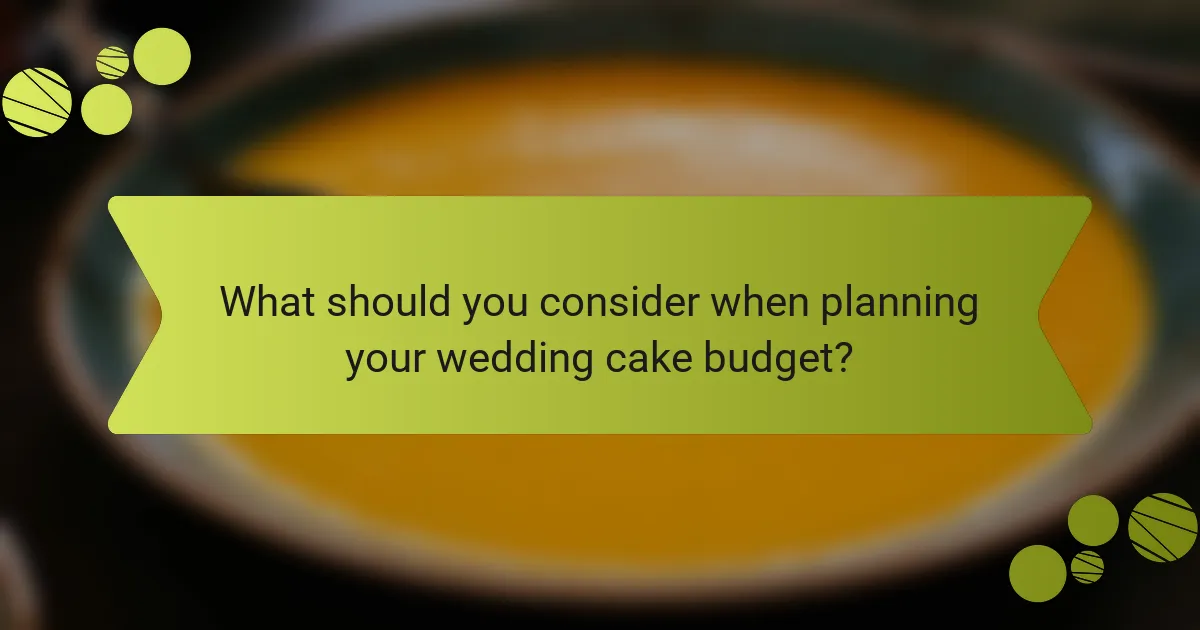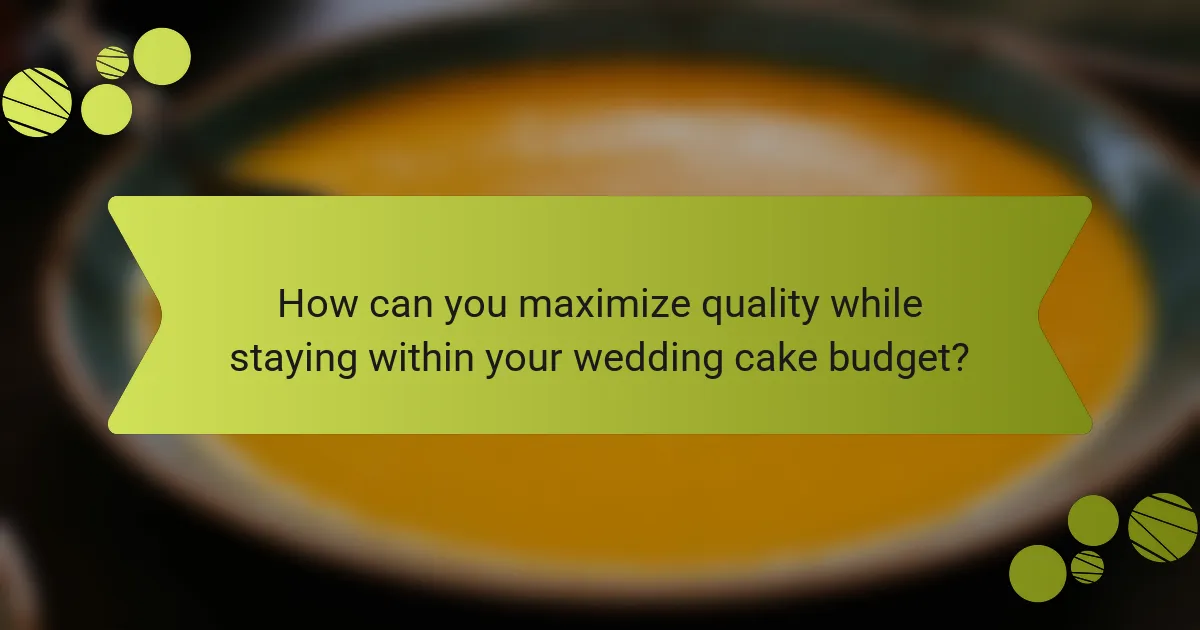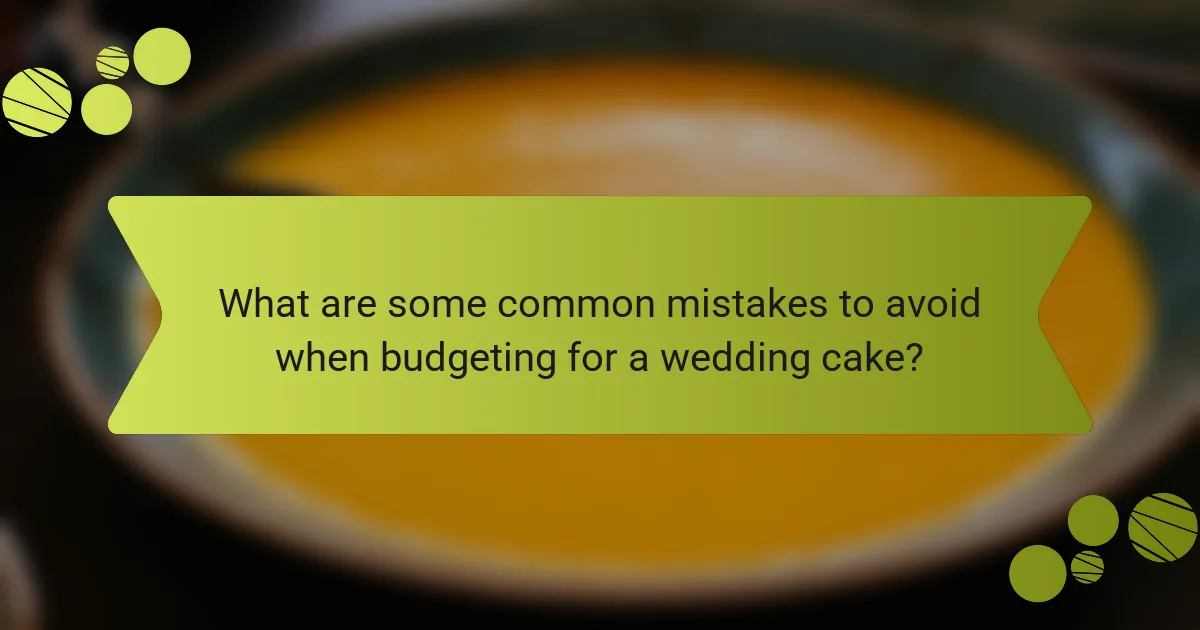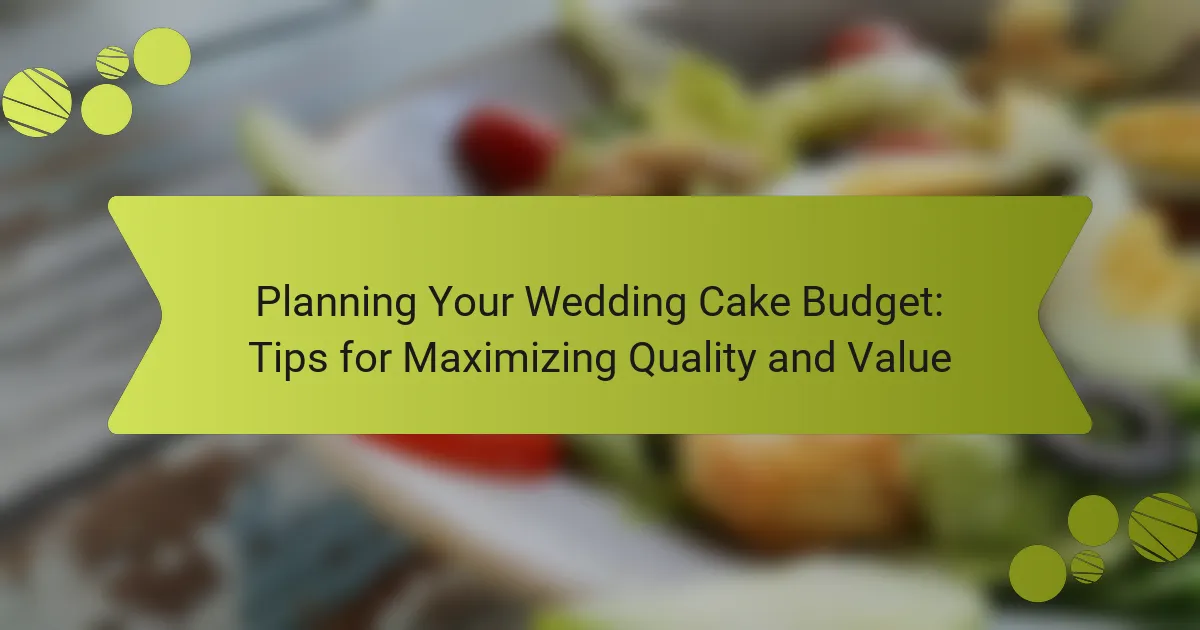Wedding cake budgeting is crucial for couples planning their special day, as the cake’s size, flavors, design complexity, and additional fees significantly influence overall costs. Key considerations include determining the number of guests, selecting cost-effective flavors, and understanding the impact of seasonal ingredient availability on pricing. Couples should also be aware of common budgeting mistakes, such as underestimating servings and failing to communicate design preferences with their baker. By researching local bakers and clearly outlining their budget, couples can maximize quality and value while ensuring their wedding cake meets their expectations.

What should you consider when planning your wedding cake budget?
When planning your wedding cake budget, consider the number of guests. The size of the cake directly affects the cost. Cake flavors and fillings also influence the budget. Specialty flavors typically increase the price. Design complexity is another factor. Intricate designs require more time and skill, raising costs. Delivery and setup fees should be included in the budget. Many bakeries charge for transportation and assembly. Seasonal availability of ingredients can impact pricing. Prices may vary based on ingredient costs throughout the year. Finally, always allocate a portion for tasting consultations. This ensures you select a cake that meets your expectations.
How can you determine your overall wedding cake budget?
To determine your overall wedding cake budget, start by assessing your total wedding budget. Allocate a percentage of this budget specifically for the cake. A common guideline is to spend about 2-3% of your total budget on the cake. Next, consider the number of guests you will be serving, as this will affect the cake size and cost. Research local bakeries to understand their pricing structures and offerings. Factor in any additional costs such as delivery fees, setup, and decorations. Finally, include a buffer for unexpected expenses, typically around 10% of your cake budget. This structured approach helps ensure that your wedding cake fits within your overall budget while meeting your expectations.
What factors influence the cost of a wedding cake?
The cost of a wedding cake is influenced by several factors. The size of the cake directly affects its price. Larger cakes require more ingredients and labor. The complexity of the design also plays a significant role. Intricate designs take more time and skill to create. The type of ingredients used impacts the cost as well. Premium ingredients lead to higher prices. The location of the bakery can influence pricing due to regional cost differences. Seasonal demand can also affect cake prices. Prices may increase during peak wedding seasons. Lastly, customization options, such as flavors and decorations, contribute to the overall cost. Each of these factors can significantly alter the final price of a wedding cake.
How does guest count affect your wedding cake budget?
Guest count directly impacts your wedding cake budget. A higher guest count requires a larger cake to serve everyone. Cakes are typically priced per slice, so more guests lead to increased costs. For example, if a cake costs $5 per slice and you have 100 guests, the total cost is $500. Additionally, larger cakes may require more intricate designs and higher-quality ingredients, further raising the budget. Therefore, planning the guest count is crucial for managing cake expenses effectively.
What are the different types of wedding cakes available?
The different types of wedding cakes available include traditional tiered cakes, sheet cakes, and cupcake towers. Traditional tiered cakes are often multi-layered and decorated elaborately. They can be made in various flavors, including vanilla, chocolate, and red velvet. Sheet cakes are simpler and typically served in a single layer. They are often more cost-effective and can be customized in flavor and design. Cupcake towers consist of individual cupcakes arranged in a visually appealing way. They offer a variety of flavors and are popular for their convenience. Each type serves different preferences and budget considerations for weddings.
What are the most popular wedding cake styles and flavors?
The most popular wedding cake styles include tiered cakes, [censured] cakes, and sheet cakes. Tiered cakes are often elaborately decorated and can have multiple flavors. [censured] cakes feature minimal frosting and showcase the cake layers, often adorned with fresh fruits or flowers. Sheet cakes are simpler and can be cut into portions for guests.
Common flavors for wedding cakes are vanilla, chocolate, and red velvet. Vanilla remains a classic choice due to its versatility. Chocolate is favored for its rich taste, while red velvet offers a unique color and flavor profile. Other popular flavors include lemon, almond, and carrot cake. These flavors cater to diverse palates and can be customized with various fillings and frostings.
How do different cake designs impact the budget?
Different cake designs significantly impact the budget. Intricate designs require more time and skill, increasing labor costs. Custom shapes and detailed decorations often use more materials, raising ingredient expenses. Cakes with multiple tiers typically cost more due to added complexity and support structures. Specialty flavors and fillings can also elevate the price. According to a survey by The Knot, couples spend an average of $500 on wedding cakes, with elaborate designs often exceeding this amount. Thus, the design complexity directly correlates with the overall cake budget.

How can you maximize quality while staying within your wedding cake budget?
Choose a skilled baker who specializes in wedding cakes. Quality often correlates with experience and reputation. Research local bakers and read reviews to find the best options. Opt for a simpler design to reduce costs while maintaining elegance. Intricate designs require more time and materials, increasing the price. Select a cake flavor that is popular and cost-effective. Classic flavors like vanilla or chocolate tend to be less expensive than gourmet options. Consider a smaller cake for display and supplement it with sheet cakes for serving. This approach maintains the visual appeal without overspending. Schedule your wedding during an off-peak season for potential discounts. Many bakers offer lower prices during less busy times. Finally, communicate your budget clearly with the baker. This transparency can lead to creative solutions that meet your quality expectations within your financial limits.
What strategies can help you find the best baker for your budget?
Research local bakeries and read reviews to assess their quality and pricing. Ask for recommendations from friends and family who have recently planned weddings. Schedule tastings with multiple bakers to compare flavors and prices. Inquire about package deals or discounts for larger orders. Clearly communicate your budget to bakers to see if they can accommodate your needs. Check for any hidden fees in contracts or quotes. Look for bakers who offer customization options that fit your budget without compromising quality. Utilize social media to find bakers showcasing their work within your price range.
How can you evaluate bakers based on quality and price?
To evaluate bakers based on quality and price, consider their portfolio of past work. Review photos of previous cakes to assess design and craftsmanship. Check online reviews and testimonials for customer satisfaction. Compare pricing structures, including per-slice costs and additional fees. Ask about ingredient quality and sourcing, as premium ingredients often indicate higher quality. Request tastings to evaluate flavor and texture directly. Inquire about customization options and flexibility in design to ensure your vision is met. Lastly, verify their experience with wedding cakes specifically, as this can impact both quality and pricing.
What questions should you ask potential bakers during consultations?
What questions to ask potential bakers during consultations include inquiries about their experience and specialties. Ask about their portfolio to see previous work. Inquire about flavor options and customization possibilities. Confirm their availability for your wedding date. Discuss pricing structures and what is included in the cost. Ask about delivery and setup services. Inquire about tasting sessions and how they handle dietary restrictions. Finally, clarify their cancellation and refund policies. These questions ensure you select a baker who meets your needs and expectations.
How can you prioritize your wedding cake features?
To prioritize your wedding cake features, first identify your must-haves. Consider flavors, design, and dietary restrictions. Next, rank these features based on importance to you and your partner. Allocate your budget according to these priorities. For example, if flavor is paramount, invest more in high-quality ingredients. A 2021 survey by The Knot revealed that 75% of couples prioritize taste over design. This data supports focusing on flavor first. Finally, communicate your priorities to your baker to ensure they align with your vision.
What elements of a wedding cake are worth splurging on?
High-quality ingredients and intricate designs are worth splurging on for a wedding cake. Premium ingredients, such as organic flour and real butter, enhance flavor and texture. Custom designs allow for personalization that reflects the couple’s style. Elaborate decorations, like sugar flowers or fondant details, create visual impact. A skilled baker can ensure the cake not only looks stunning but also tastes exceptional. Investing in these elements can elevate the overall experience for guests.
How can you cut costs without compromising on taste or aesthetics?
Choose seasonal ingredients to reduce costs while maintaining flavor. Seasonal items are often fresher and less expensive. Opt for simpler designs that require less intricate work. This approach can still look elegant without high costs. Consider smaller cake sizes paired with a dessert table. This maintains aesthetics and offers variety. Limit the use of fondant, as buttercream can be more cost-effective and tasty. Research shows that buttercream cakes are often preferred for flavor. Use local bakers who may offer competitive pricing without sacrificing quality. These strategies ensure taste and appearance while effectively managing the budget.

What are some common mistakes to avoid when budgeting for a wedding cake?
Common mistakes to avoid when budgeting for a wedding cake include not setting a clear budget from the start. This can lead to overspending or last-minute adjustments. Another mistake is failing to consider all costs associated with the cake. Delivery fees, setup charges, and taxes can add up. Additionally, couples often underestimate the number of servings needed. This can result in ordering too little cake, leading to extra costs for additional servings. Not researching cake vendors is also a frequent error. Couples should compare prices and reviews to ensure they receive quality. Lastly, neglecting to communicate design preferences can lead to unexpected charges. Clear communication with the baker will help align expectations and budget.
How can miscalculating portion sizes affect your budget?
Miscalculating portion sizes can significantly impact your budget by leading to excess waste or insufficient servings. When portion sizes are overestimated, more ingredients are purchased than necessary. This results in higher costs for ingredients, labor, and potentially wasted cake. Conversely, underestimating portion sizes can lead to shortages, requiring last-minute purchases that are often more expensive. A study by the Food Waste Reduction Alliance found that food waste can account for 30-40% of the total food supply, indicating substantial financial loss. Accurate portion sizing helps control costs and ensures all guests are served adequately.
What are the risks of underestimating the complexity of cake designs?
Underestimating the complexity of cake designs can lead to significant risks. One major risk is budget overruns. Complex designs often require more time and specialized skills, increasing costs unexpectedly. Another risk is the potential for poor quality. Rushed or underestimated designs may compromise taste and aesthetics. Additionally, there is a risk of delivery issues. Intricate cakes may be more challenging to transport, leading to damage. Lastly, underestimating complexity can result in unmet expectations. Clients may be disappointed if the final product does not match their vision due to oversights in planning.
What tips can help you stick to your wedding cake budget?
Set a clear budget for your wedding cake. Determine how much you can afford before shopping. Research average cake prices in your area. This will help you gauge what is reasonable. Choose a simple design to reduce costs. Intricate designs often require more time and materials. Limit the number of tiers to save money. A smaller cake can still be beautiful and delicious. Consider serving sheet cakes in addition to the main cake. This can reduce overall expenses while providing enough servings. Order a smaller cake for display and serve guests with less expensive options. Lastly, book your cake early to secure better pricing. Many bakers offer discounts for early orders.
How can you create a realistic budget for your wedding cake?
To create a realistic budget for your wedding cake, start by determining the total amount you can allocate. Research average costs in your area, as wedding cake prices typically range from $2 to $10 per slice. Calculate the number of guests to estimate the total number of slices needed. Include additional costs such as delivery fees, setup, and any decorative elements. Prioritize your cake’s design and flavor preferences, as these can significantly affect the price. Consult multiple bakers for quotes to compare pricing and services. Finally, set aside a small portion of your budget for unexpected expenses, ensuring you have flexibility.
What are some creative alternatives to traditional wedding cakes?
Some creative alternatives to traditional wedding cakes include cupcakes, doughnut towers, and dessert tables. Cupcakes offer individual servings and can be customized in flavors and designs. Doughnut towers create a fun, whimsical display while providing a variety of flavors. Dessert tables can feature an assortment of sweets like cookies, pastries, and candies, allowing guests to choose their favorites. These options can be more cost-effective and cater to diverse tastes. Additionally, they can enhance the wedding theme and atmosphere, making the celebration more memorable.
The main entity of this article is the wedding cake budget. It provides essential considerations for planning a wedding cake budget, including guest count, cake size, flavors, design complexity, and additional costs such as delivery and setup fees. The article outlines strategies to determine an overall budget, factors influencing cake costs, popular cake types and styles, and tips for maximizing quality while staying within budget. Additionally, it highlights common budgeting mistakes to avoid and offers creative alternatives to traditional wedding cakes, ensuring couples can make informed decisions that align with their financial expectations.
